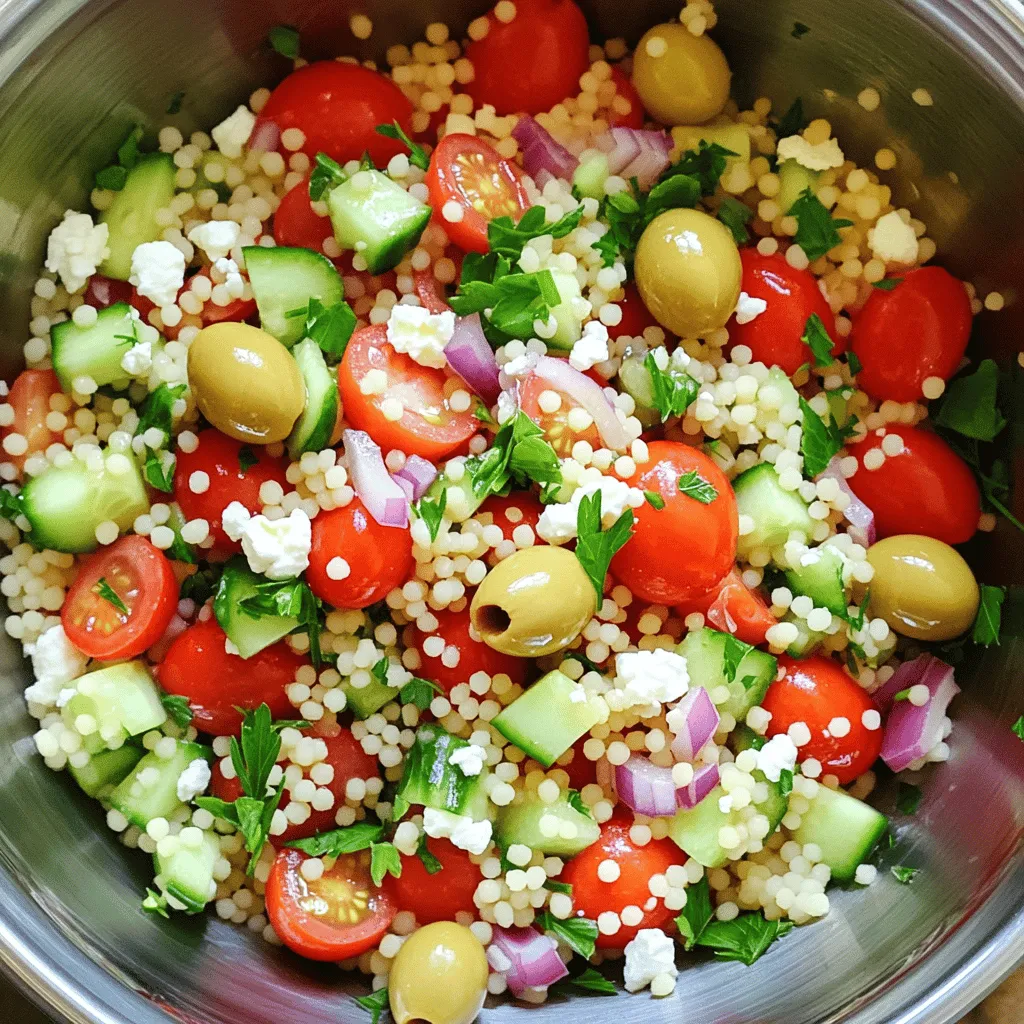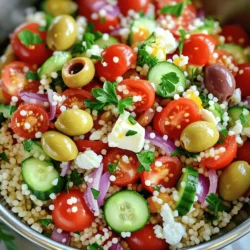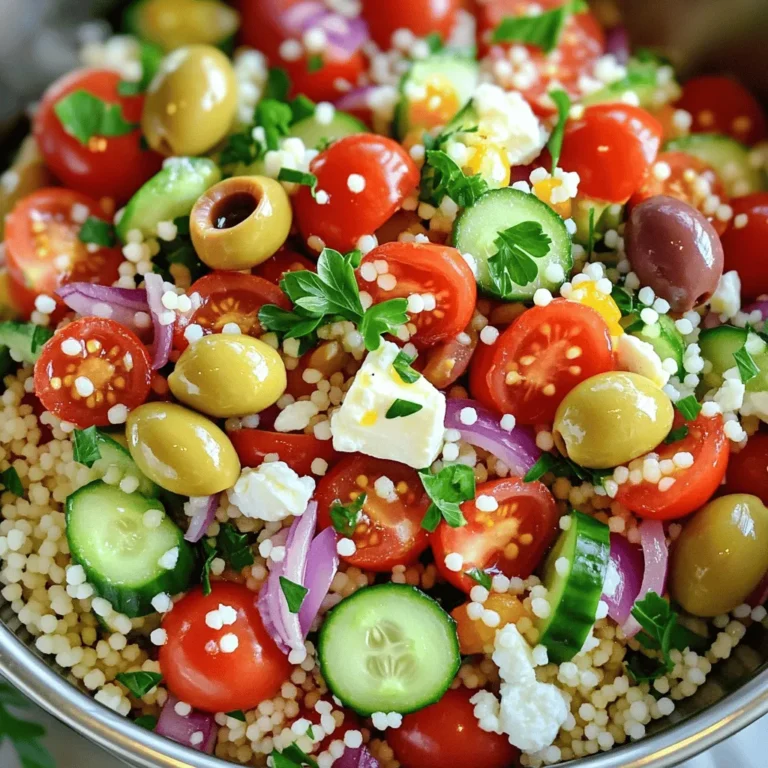Are you ready to brighten up your meals with a vibrant Mediterranean Couscous Salad? This fresh and flavorful dish combines simple ingredients to create a delightful mix of taste and nutrition. Packed with colorful veggies, creamy feta, and zesty dressing, it’s perfect for any occasion. In this blog post, I’ll guide you through easy steps to make this salad, plus share tips for variations and storage. Let’s dive in!
Ingredients
List of Ingredients
– Couscous and Broth
– 1 cup couscous
– 1 1/4 cups vegetable broth (or water)
– Fresh Vegetables
– 1/2 cup cherry tomatoes, halved
– 1/2 cucumber, diced
– 1/4 red onion, finely chopped
– 1/2 red bell pepper, diced
– Feta Cheese and Olives
– 1/4 cup Kalamata olives, pitted and sliced
– 1/4 cup feta cheese, crumbled
– Dressing Components
– 1/4 cup fresh parsley, chopped
– 2 tablespoons olive oil
– 1 tablespoon lemon juice
– 1 teaspoon dried oregano
– Salt and pepper to taste
This salad shines with fresh flavors. The couscous pairs well with the broth, which adds depth. I love using vegetable broth for a richer taste. The fresh vegetables bring color and crunch. Cherry tomatoes burst with juice, while cucumbers add coolness. Red onion and bell pepper give a nice kick.
Feta cheese and olives add a savory touch. Feta crumbles beautifully and melts in your mouth. Kalamata olives bring a briny flavor that balances the dish.
The dressing is simple but so tasty. Olive oil adds richness, while lemon juice brightens everything. Dried oregano adds a herby note, and salt and pepper tie it all together. This blend makes each bite exciting and fresh.
Step-by-Step Instructions
Cooking Couscous
Bringing Broth to a Boil
Start by pouring 1 1/4 cups of vegetable broth into a medium saucepan. Turn the heat to high and bring it to a boil. This step is key. The hot broth will cook the couscous evenly and add flavor.
Soaking and Fluffing Couscous
Once the broth boils, add 1 cup of couscous. Stir it well, then cover the pot. Take it off the heat and let it sit for about 5 minutes. The couscous will soak up the broth. After 5 minutes, use a fork to fluff the couscous. This keeps it light and airy. Let it cool down while you prepare the salad.
Preparing the Salad
Combining Fresh Ingredients
In a large bowl, combine these fresh ingredients:
– 1/2 cup cherry tomatoes, halved
– 1/2 cucumber, diced
– 1/4 red onion, finely chopped
– 1/2 red bell pepper, diced
– 1/4 cup Kalamata olives, pitted and sliced
– 1/4 cup feta cheese, crumbled
– 1/4 cup fresh parsley, chopped
Mix them well to ensure every bite is colorful and tasty.
Whisking the Dressing Together
In a small bowl, whisk together:
– 2 tablespoons olive oil
– 1 tablespoon lemon juice
– 1 teaspoon dried oregano
– Salt and pepper to taste
This dressing adds a zesty kick. Make sure it’s well mixed.
Mixing and Chilling
Incorporating Couscous with Veggies
Add the cooled couscous to the bowl with the fresh vegetables. Pour the dressing over the top. Gently toss everything together. Make sure each piece of couscous gets coated in the dressing.
Refrigerating for Flavor Development
Cover the salad with plastic wrap or a lid. Place it in the fridge for at least 30 minutes. This chilling time allows the flavors to blend. When you take it out, you’ll have a tasty, refreshing dish ready to enjoy!
Tips & Tricks
Perfecting the Texture
Fluffing Tips for Couscous
To make your couscous light and fluffy, let it steam properly. After boiling your broth, mix in the couscous and cover. Remove it from heat and wait five minutes. This helps it absorb the liquid well. Use a fork to fluff it gently. This step makes a big difference!
Balancing Flavors in Your Salad
Balancing flavors is key. Use fresh ingredients like cherry tomatoes, cucumber, and red onion. Each brings a unique taste. The salty feta and olives add depth. Add lemon juice and olive oil for brightness. Taste as you mix to adjust seasoning. This ensures a perfect blend of flavors.
Presentation Ideas
Serving Suggestions
Serve your salad in a large bowl. You can also use individual plates for a fancy touch. Drizzle extra olive oil and lemon juice on top. This not only adds flavor but also looks appealing.
Garnishing Tips for Visual Appeal
For a pop of color, add extra parsley on top. Whole olives can also make the dish stand out. A beautiful presentation makes the salad more inviting. You want your guests to be excited to dig in!
Health and Nutritional Benefits
Nutritional Highlights of Ingredients
This salad is packed with nutrients. Couscous provides carbs for energy. Fresh veggies bring vitamins and minerals. Feta adds protein and calcium. Olive oil is heart-healthy too. This salad is a wholesome choice for any meal.
Substitutions for a Healthier Option
If you want a lighter salad, swap regular couscous for whole grain or cauliflower couscous. Try using low-fat feta for fewer calories. You can also add more veggies like spinach or bell peppers. These changes keep your salad healthy and tasty!

Variations
Ingredient Swaps
Using Different Vegetables
You can easily swap out vegetables in this salad. Try adding bell peppers, zucchini, or even carrots. Each veggie brings its flavor. Mix and match based on what you have at home. For a crunch, add radishes or snap peas.
Alternative Cheeses
Feta cheese is fantastic, but you can use others too. Try goat cheese for a tangy taste. You can also use mozzarella for a milder flavor. Cheese choices can change the whole salad vibe.
Seasonal Adjustments
Adding Seasonal Produce
In spring, add fresh peas or asparagus for a bright touch. During summer, corn and ripe tomatoes shine in this dish. In fall, consider roasted butternut squash or Brussels sprouts. These seasonal swaps keep the salad exciting.
Adapting for Fall or Summer Themes
For a summer feel, use lighter dressings with lemon or vinaigrette. In fall, add warm spices like cinnamon or nutmeg. These changes make the salad fit the season perfectly.
Dressing Alternatives
Experimenting with Different Dressings
The dressing can change everything! Try a balsamic vinaigrette for a sweet twist. A yogurt-based dressing adds creaminess. Don’t be afraid to mix flavors until you find your favorite.
Using Homemade vs. Store-Bought Options
Homemade dressings are fresh and simple. Just mix olive oil, vinegar, and spices. Store-bought options are quick and easy. Both can work well, so choose what fits your time and taste.
Storage Info
Best Practices for Refrigeration
Store your Mediterranean Couscous Salad in an airtight container. This keeps it fresh and tasty. You can use glass or plastic containers. Make sure the salad is cool before you cover it. This helps avoid moisture buildup, which can make it soggy.
For the best taste, eat the salad within three days. The flavors will stay great for this time. After three days, the veggies may start to lose their crunch.
Freezing Couscous Salad
You can freeze Mediterranean Couscous Salad, but there are some tips. First, store it in a freezer-safe container. Leave some space at the top because the salad will expand as it freezes.
When you want to eat it, thaw it in the fridge overnight. This helps keep the texture nice. After thawing, stir the salad gently. You might want to add a little olive oil or lemon juice to refresh the flavors.
FAQs
How long does Mediterranean Couscous Salad last in the fridge?
Mediterranean Couscous Salad stays fresh for about three to four days in the fridge. Store it in an airtight container. This keeps the flavors bright and the veggies crisp. After a few days, the salad may lose its crunch.
Can I make this salad ahead of time?
Yes! You can make this salad a day ahead. It tastes even better after resting. The flavors mix well when the salad sits in the fridge. Just remember to stir it lightly before serving.
Is couscous gluten-free?
No, couscous is not gluten-free. It is made from wheat. If you need a gluten-free option, use quinoa or rice instead of couscous. Both are tasty and work well in this salad.
What can I serve with Mediterranean Couscous Salad?
You can serve this salad with grilled chicken or fish. It also pairs well with hummus and pita bread. For a light meal, enjoy it with a side of tzatziki or a yogurt dip.
This blog post shared an easy way to make Mediterranean Couscous Salad. We explored key ingredients like couscous, fresh veggies, feta cheese, and olives. I outlined simple steps to cook, mix, and chill the dish. I included tips for perfecting texture and presentation and even discussed healthy substitutions. Remember, you can adjust ingredients to fit the season. Enjoy storing and changing your salad for days to come. This dish is simple, versatile, and delicious. Happy cooking!


